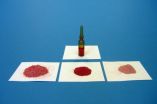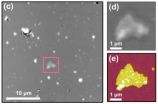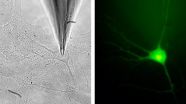(Press-News.org) National Institute of Standards and Technology (NIST) researchers have developed new certified reference materials for measuring amounts of organic acids in dietary supplements formulated with Vaccinium berries—cranberries, blueberries and bilberries. As described in a recent paper,* manufacturers and researchers can use this new suite of standard reference materialsTM (SRMs) as quality assurance tools.
berry SRMs
Dietary supplement manufacturers often include health claims on products made with Vaccinium berries. Suggested benefits include prevention of urinary tract infections, reduced risk of certain cancers or Alzheimer's disease, and improved night vision. Consumers may take such claims at face value, but one common problem with dietary supplement products containing berries is the risk of economic adulteration—dilution with less expensive juices, such as apple or grape, or the use of blueberries instead of bilberries as a cost-saver for the manufacturer. One way of telling whether or not a product has been adulterated is to measure organic acid ratios, which are specific to each type of berry.
Until now, analytical approaches for measuring organic acid ratios in berries, fruit juices, and dietary supplements have relied on the use of pure organic acid reference standards, which do not take into account the complexity of the whole berry. As a result, these methods could neither be validated as accurate nor used to certify reference materials to meet the needs and accuracy requirements of the Food and Drug Administration (FDA) and dietary supplement manufacturers.
NIST's new certified reference materials are:
SRM 3281 Cranberry (Fruit)
SRM 3282 Low-Calorie Cranberry Juice Cocktail
SRM 3283 Cranberry Extract
SRM 3284 Cranberry-Containing Solid Oral Dosage Form
SRM 3285 Mixed Berry-Containing Solid Oral Dosage Form
SRM 3287 Blueberry (Fruit)
SRM 3291 Bilberry Extract
The seven SRMs were created as part of an ongoing collaboration to develop dietary supplement SRMs, involving NIST, the National Institutes of Health's Office of Dietary Supplements, and the FDA's Center for Drug Evaluation and Research.
SRMs are among the most widely distributed and used NIST products. The agency prepares, analyzes and distributes more than 1,000 different carefully characterized materials that are used throughout the world to check the accuracy of instruments and test procedures used in manufacturing, clinical chemistry, environmental monitoring, electronics, criminal forensics and dozens of other fields. For more information, see NIST's SRM website.
INFORMATION:
More information about the Vaccinium berry suite of SRMs.
* M.M. Phillips, R.J. Case, C.A. Rimmer, L.C. Sander, K.E. Sharpless, S.A. Wise, and J.H. Yen. Determination of organic acids in Vaccinium berry standard reference materials. Analytical and Bioanalytical Chemistry. 398(1), 425-434.
New NIST dietary supplement reference materials could be 'berry' useful
2010-11-11
ELSE PRESS RELEASES FROM THIS DATE:
Academies of science call for amendments to impracticable Genetic Diagnostics Act
2010-11-11
Many aspects of the German Genetic Diagnostics Act (Gendiagnostikgesetz) are out of touch with the latest technology, almost impossible to implement in clinical practice, or even detrimental to the success of recognised screening tests, such as newborn screening. The Act, which came into force in February 2010, is in desperate need of amendment. This was the conclusion reached by the Academy Workgroup "Predictive genetic diagnostics as an instrument of disease prevention" of the German Academy of Sciences Leopoldina, the Berlin-Brandenburg Academy of Sciences and Humanities ...
NIST pings key material in sonar, closes gap on structural mystery
2010-11-11
Using a neutron beam as a probe, researchers working at the National Institute of Standards and Technology (NIST) have begun to reveal the crystal structure of a compound essential to technologies ranging from sonar to computer memory. Their recent work* provides long-sought insight into just how a widely used material of modern technology actually works.
The compound is a "piezoelectric," a material capable of changing one kind of energy into another—mechanical to electrical, or vice versa. Long employed in sonar systems to detect sound waves, more recently piezoelectrics ...
Looking for wireless? Try a local farm
2010-11-11
VIDEO:
Wireless. For most, the word conjures images quaint coffee shops or busy airport lobbies -- places where people drop in to check on business or check in with other people.
But...
Click here for more information.
BEAUMONT – Wireless. For most, the word conjures images quaint coffee shops or busy airport lobbies – places where people drop in to check on business or check in with other people.
But increasingly "wireless" is showing up on the farm to help produce better ...
AFM positioning: Shining light on a needle in a haystack
2010-11-11
The researchers characterize their new technique as a neat solution to the "needle in a haystack" problem of nanoscale microscopy, but it's more like the difference between finding the coffee table in a darkened room either by walking around until you fall over it, or using a flashlight. In a new paper,* a group from JILA—a joint venture of the National Institute of Standards and Technology (NIST) and the University of Colorado—finds tiny assemblies of biomolecules for subsequent detailed imaging by combining precision laser optics with atomic force microscopy.
The ...
Synapses recycle proteins for the release of neurotransmitters
2010-11-11
Neurons communicate via chemical transmitters which they store in the bubble-like synaptic vesicles and release as required. To be able to react reliably to stimulation, neurons must have a certain number of "acutely releasable" vesicles. With the help of a new method, neuroscientists at the Max Planck Institute of Experimental Medicine in Göttingen have now discovered that neurons systematically recycle the protein components necessary for transmitter release and in this way guarantee the reliability of signal transmission in the brain. If this process is disrupted, the ...
Portrait of gambling behavior in Quebec
2010-11-11
Montreal, November 10, 2010 – The initial findings of a survey on the prevalence of gambling in Quebec have been released. The study also deals with behavior problems associated with gambling. The study reveals that nearly 70 percent of Quebec adults report having bet or spent money on gambling during the previous 12 months. It also found Quebecers spend an average of $483 annually on gambling activities.
This survey was conducted between June and September 2009 throughout the province among 11,888 non-institutionalized adults over the age of 18. It constitutes the first ...
Army-funded technology detects bacteria in water
2010-11-11
November 10, 2010 -- To keep soldiers in the battlefield healthy, the U.S. Army is exploring new ways to detect harmful bacteria in water.
Current techniques for analyzing water in the field can take as long as 24 hours to complete, according to Bart Lipkens of Western New England College in Springfield, Massachusetts and his colleagues at Physical Sciences in Andover, Ma.
They are working on an alternative technology that uses sound waves to accelerate the process.
"The goal of our project is to speed up the detection of bacteria in water supplies," said Lipkens. ...
Evolutionary bestseller in image processing
2010-11-11
The eye is not just a lens that takes pictures and converts them into electrical signals. As with all vertebrates, nerve cells in the human eye separate an image into different image channels once it has been projected onto the retina. This pre-sorted information is then transmitted to the brain as parallel image sequences. Scientists from the Max Planck Institute of Neurobiology in Martinsried have now discovered that fruit flies process optical information in a similar way. The evidence suggests that this type of wiring is an effective energy-saving mechanism and is therefore ...
Out-sniffing bomb-sniffing dogs
2010-11-11
Dogs have long been called man's best bomb detector –– until now.
A Tel Aviv University scientist leads a research team that has developed a powerful electronic sensor to detect multiple kinds of explosives –– including those used in the recent Yemeni bomb threat. Based on nanotechnology advances, the new sensor is small, portable, and is more sensitive and reliable at detecting explosives than any sniffer dog, says its lead researcher Prof. Fernando Patolsky of Tel Aviv University's Raymond and Beverly Sackler School of Chemistry.
With scientific findings on it published ...
GM, Chrysler bankruptcies created troubling legacy, legal scholars say
2010-11-11
CHAMPAIGN, Ill. — The Chrysler and General Motors bankruptcy reorganizations represented a sea change in corporate restructuring, one that could portend the end of our current system of bankruptcy reorganization, according to a published article by two University of Illinois experts in bankruptcy law.
Law professors Charles J. Tabb and Ralph Brubaker argue that the legal principles applied in the GM and Chrysler bankruptcies – two of the largest in U.S. history at $83.5 and $39.9 billion, respectively – were misguided, and ultimately have undermined the distributional ...






